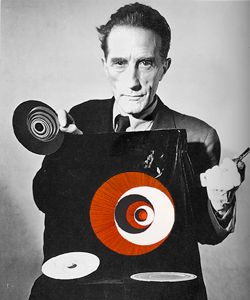Art history repeats itself, first as tragedy, then as farce. In the 20th century the tragedy is Marcel Duchamp, though Duchamp himself would be the first to deny it. As anyone will testify who has ever seen Nude Descending a Staircase, which Duchamp painted in 1912, at 25, he was a great painter. By 1914 he was finished painting. Robert Lebel, author of a book about Duchamp, writes of this “crisis” as follows:
It was as early as the end of 1912 that Duchamp suffered the great intellectual crisis that progressively forced him to abandon this mode of expression which seemed vitiated to him. The practice of drawing and painting appeared to him as a kind of trickery that tended towards the senseless glorification of the hand and of nothing else.
 Uh-huh. No one really knows why Duchamp quit painting, he was a strange cat. Perhaps he was annoyed at the failure of the art estabishment to appreciate Nude Descending, which the prestigious Salon des Independánts in Paris rejected, although it was shown in a Cubist exhibition in Spain at the time and a couple years later at the Armory. Perhaps, as he said, he painted only 33 canvases because he had only 33 ideas. Perhaps he was just lazy. Likely it was all of the above. Whatever the reason, he spent the rest of his career playing elaborate practical jokes, mostly on people like Lebel, and chess, mostly with his buddy and fellow prankster Man Ray.
Uh-huh. No one really knows why Duchamp quit painting, he was a strange cat. Perhaps he was annoyed at the failure of the art estabishment to appreciate Nude Descending, which the prestigious Salon des Independánts in Paris rejected, although it was shown in a Cubist exhibition in Spain at the time and a couple years later at the Armory. Perhaps, as he said, he painted only 33 canvases because he had only 33 ideas. Perhaps he was just lazy. Likely it was all of the above. Whatever the reason, he spent the rest of his career playing elaborate practical jokes, mostly on people like Lebel, and chess, mostly with his buddy and fellow prankster Man Ray.
They were terrific jokes too. Beginning in 1915 Duchamp produced a series of what he called “readymades,” like In Advance of the Broken Arm (a snow shovel), and the notorious Fountain, an unadorned urinal, signed “R. Mutt,” that his exhibitors, in New York, did not appreciate. By the rules of the exhibition they couldn’t send it back; they hid it behind a curtain instead. It wound up in the Museum of Modern Art, and Duchamp, as usual, had the last laugh. Then there is the bicycle wheel embedded in the stool (also in MOMA), the glass ampule labeled “Paris Air” (Duchamp unfortunately did not live to see the Pet Rock, which he would have appreciated), and the final gesture of desecration, the Mona Lisa with a mustache. Duchamp was once asked to sign a Mona Lisa reproduction; he wrote “Shaved.”
The farce is Andy Warhol. Warhol was a moderately talented fashion illustrator who specialized in shoes and quickly realized that his real talent was not for art but hucksterism. Warhol’s true metier is the interview; it is not for nothing that he created a magazine by the same name. The interviews Warhol gave in the 60s are priceless. An excerpt from one I remember goes something like this:
Girl art journo (in cat glasses): If I could ask you a question about your electric chair series [Warhol silk-screened photographs of electric chairs for a while], Mr. Warhol… Did you mean to suggest, by isolating the electric chair, that modern capitalist society has dehumanized death, by sanitizing it?
[Five-second pause.]
Andy (in sunglasses): No.
Warhol famously made movies, indescribably dull movies, like the 12-hour shot of the Empire State Building whose only action is a bird flying by every half hour or so. He was often asked why he gave up painting for movies. “Because it’s easier,” he would say. He once advertised in The Village Voice that he would endorse anything for money. The beauty of these jokes is that they were literally true.
No jokes, however, are funny after the first couple times you’ve heard them, and these days it is hard to raise more than a yawn when you hear that the Tate Gallery has bought tin cans of some poor lunatic’s excrement. Nonetheless, we should remember that it was funny once. Duchamp and Warhol have an indelible place in history, though it may not be in art history — possibly the history of humor, or public relations.
(Update: Brian Micklethwait comments.)
